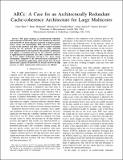ARCc: A case for an architecturally redundant cache-coherence architecture for large multicores
Author(s)
Khan, Omer; Hoffmann, Henry Christian; Lis, Mieszko; Hijaz, Farrukh; Agarwal, Anant; Devadas, Srinivas; ... Show more Show less
DownloadDevadas-ARCc.pdf (647.1Kb)
OPEN_ACCESS_POLICY
Open Access Policy
Creative Commons Attribution-Noncommercial-Share Alike
Terms of use
Metadata
Show full item recordAbstract
This paper proposes an architecturally redundant cache-coherence architecture (ARCc) that combines the directory and shared-NUCA based coherence protocols to improve performance, energy and dependability. Both coherence mechanisms co-exist in the hardware and ARCc enables seamless transition between the two protocols. We present an online analytical model implemented in the hardware that predicts performance and triggers a transition between the two coherence protocols at application-level granularity. The ARCc architecture delivers up to 1.6× higher performance and up to 1.5× lower energy consumption compared to the directory-based counterpart. It does so by identifying applications which benefit from the large shared cache capacity of shared-NUCA because of lower off-chip accesses, or where remote-cache word accesses are efficient.
Date issued
2011-10Department
Massachusetts Institute of Technology. Department of Electrical Engineering and Computer ScienceJournal
Proceedings of the IEEE International Conference on Computer Design, ICCD 2011
Publisher
Institute of Electrical and Electronics Engineers
Citation
Khan, Omer et al. “ARCc: A Case for an Architecturally Redundant Cache-coherence Architecture for Large Multicores.” IEEE, 2011. 411–418. Web.
Version: Author's final manuscript
Other identifiers
INSPEC Accession Number: 12386634
ISBN
978-1-4577-1953-0
ISSN
1063-6404